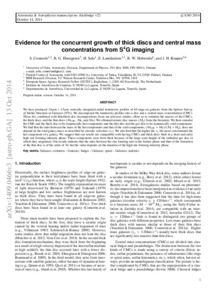Evidence for the concurrent growth of thick discs and central mass concentrations from S 4 G imaging
Comerón S.; Elmegreen B.; Salo H.; Laurikainen E.; Holwerda B.; Knapen J.
https://urn.fi/URN:NBN:fi-fe2021042714384
Tiivistelmä
We have produced 3.6 μm + 4.5 μm vertically integrated radial luminosity profiles of 69 edge-on galaxies from the Spitzer Survey of Stellar Structure in Galaxies (SG). We decomposed the luminosity profiles into a disc and a central mass concentration (CMC). These fits, combined with thin/thick disc decompositions from our previous studies, allow us to estimate the masses of the CMCs, the thick discs, and the thin discs (α, α, and α). We obtained atomic disc masses (α) from the literature. We then consider the CMC and the thick disc to be dynamically hot components and the thin disc and the gas disc to be dynamically cold components. We find that the ratio between the mass of the hot components and that of the cold components, (α + α)/(α + α), does not depend on the total galaxy mass as described by circular velocities (v). We also find that the higher the v, the more concentrated the hot component of a galaxy. We suggest that our results are compatible with having CMCs and thick discs built in a short and early high star forming intensity phase. These components were born thick because of the large scale height of the turbulent gas disc in which they originated. Our results indicate that the ratio between the star forming rate in the former phase and that of the formation of the thin disc is of the order of 10, but the value depends on the duration of the high star forming intensity phase.
Kokoelmat
- Rinnakkaistallenteet [27094]
